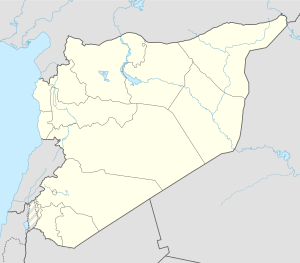Namir, Shaykh Maskin
Namir
نامر | |
|---|---|
Village | |
| Coordinates: 32°47′41″N 36°13′8″E / 32.79472°N 36.21889°E | |
| Grid position | 264/245 PAL |
| Country | |
| Governorate | Daraa |
| District | Izra |
| Subdistrict | Shaykh Maskin |
| Population (2004 census)[1] | |
• Total | 2,507 |
| Time zone | UTC+2 (EET) |
| • Summer (DST) | UTC+3 (EEST) |
Namir (Arabic: نامر, romanized: Nāmir, also transliterated Namer, Namr, Nimr), also known as Namir al-Hawa, is a village in southern Syria, administratively belonging to the Izra' District of the Daraa Governorate. In the 2004 census by the Central Bureau of Statistics, Namir had a population of 2,507.[1] Its inhabitants include Sunni Muslims and Christians.[2]
Location
[edit]Namir is situated at an elevation of 580 meters (1,900 ft) above sea level. It is south of the district capital of Izra, southeast of the subdistrict capital Shaykh Maskin, northeast of the governorate capital of Daraa, north of Khirbet Ghazaleh, and northwest of al-Hirak. The area in which Namir lies is characterized by its rich soils and moderate rainfall, historically providing Namir with significant agricultural bounty and relatively sufficient water resources.[3]
History
[edit]Namir was mentioned by the 4th-century historian Eusebius. The 5th-century historian Jerome noted that it was a significant settlement and a place used by Nabatean nomads to encamp and convene.[3]
During Mamluk rule (1260s–1517), Namir was part of the wilaya of Adhri'at (Daraa).[3]
Ottoman period
[edit]With the advent of Ottoman rule in Syria in 1517, Namir or part of its revenues were granted as a tax-exempt timar (fief) to the amir al-arab (commander of the Bedouin), which was a hereditary office of the Al Hayar family.[4] It was the center of the Banu Malik al-Ashraf nahiye (subdistrict) of the Hauran Sanjak.[5] In 1596 it appeared in the Ottoman tax registers under the name of 'Tamir'. It had a Muslim population consisting of 98 households and 45 bachelors. They paid a fixed tax-rate of 40% on agricultural products, including wheat (7,800 akçe), barley (820 a.), summer crops (610 a.), goats and bee-hives (1500 a.), inanition to winter pastures (407 a.) and "occasional revenues"(610 a.); a total of 11,467 akçe. 9/24 of the income went to a waqf (endowment).[6]
Namir had a Muslim population in 1838.[7]
Post-Syrian independence
[edit]Namir is one of a few towns in the Daraa Governorate with a significant Christian population.[2][8] During the Syrian civil war, some of the Christians of Namir joined the local branch of the Popular Committees, organized by the National Defense Forces, which played an auxiliary role in the Syrian Army's recapture of nearby Khirbet Ghazaleh from Free Syrian Army rebels in May 2013.[8]
References
[edit]- ^ a b General Census of Population and Housing 2004. Syria Central Bureau of Statistics (CBS). Daraa Governorate. (in Arabic)
- ^ a b al-Abazid, Wisam (14 March 2024). "Daraa's Christians persist in rituals amid Syrian crisis". North Press Agency. Retrieved 21 November 2024.
- ^ a b c Elisséeff 1993, p. 946.
- ^ Bakhit 1972, pp. 232–233.
- ^ Bakhit 1972, p. 279.
- ^ Hütteroth & Abdulfattah 1977, p. 213.
- ^ Robinson & Smith 1841, p. 152.
- ^ a b Heras, Nicholas A. (June 2014). "A Profile of Syria's Strategic Dar'a Province". CTC Sentinel. 7 (6). Combating Terrorism Center. Retrieved 21 November 2024.
Bibliography
[edit]- Bakhit, Muhammad Adnan Salamah (February 1972). The Ottoman Province of Damascus in the Sixteenth Century (PhD). School of Oriental and African Studies, University of London. S2CID 190680221.
- Elisséeff, N. (1993). "Namāra—3. Modern Nāmir (Namr, Nimr) al-Hawāʾ". In Bosworth, C. E.; van Donzel, E.; Heinrichs, W. P. & Pellat, Ch. (eds.). The Encyclopaedia of Islam, Second Edition. Volume VII: Mif–Naz. Leiden: E. J. Brill. pp. 944–947. ISBN 978-90-04-09419-2.
- Hütteroth, W.-D.; Abdulfattah, K. (1977). Historical Geography of Palestine, Transjordan and Southern Syria in the Late 16th Century. Erlanger Geographische Arbeiten, Sonderband 5. Erlangen, Germany: Vorstand der Fränkischen Geographischen Gesellschaft. ISBN 3-920405-41-2.
- Robinson, E.; Smith, E. (1841). Biblical Researches in Palestine, Mount Sinai and Arabia Petraea: A Journal of Travels in the year 1838. Vol. 3. Boston: Crocker & Brewster.

